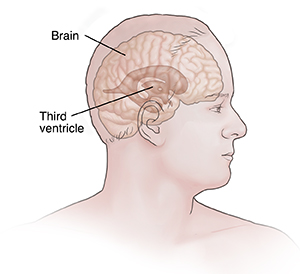Having Endoscopic Third Ventriculostomy
Endoscopic third ventriculostomy (ETV) is a type of brain surgery. It treats hydrocephalus. This condition occurs when cerebrospinal fluid (CSF) builds up in the brain. CSF surrounds and cushions the brain and spinal cord. The brain normally has a certain level of CSF in it. Too much of this fluid can cause undue pressure on the brain, which can cause brain damage.
During ETV, a healthcare provider puts a thin, flexible tube called an endoscope into the brain. The endoscope has a camera on the end of it. It sends images to a screen, so the provider can see inside the brain. Through the endoscope, the provider makes a hole in the bottom of the third ventricle in the brain. A ventricle is a space in the brain filled with CSF. Making the hole lets CSF flow more freely between the brain and the rest of the nervous system.
 |
| Normal brain. |
How to say it
ehn-doh-SKAH-pihk therd vehn-TRIH-kyoo-LAH-stoh-mee
Why is ETV done?
ETV is sometimes done in place of a ventriculoperitoneal (VP) shunt. A VP shunt is another way to treat hydrocephalus. It uses a tube (catheter) to carry CSF out of the brain to the lining of the abdomen (peritoneum). This tube runs just under the skin. A small valve connected to the tube helps control the flow of CSF from the brain.
Compared to a VP shunt, ETV may have a lower risk for long-term health problems. But ETV is not always an option. It’s used mainly to treat a certain type of hydrocephalus. That is when it's caused by a blockage in the brain. The block leads to a buildup of CSF in the ventricles.
What happens before ETV?
Your healthcare provider will ask about your health. They will also give you a physical exam. You may also need some tests, such as blood work and imaging tests.
Tell your healthcare provider about all the medicines you take. That includes prescriptions, over-the-counter medicines, and supplements. Also, tell your provider if you have any allergies.
You may be asked not to eat or drink anything for a certain time before the procedure.
What happens during ETV?
ETV is done in a hospital. It takes about 1 to 2 hours. During the procedure:
-
You are given medicine to help you relax and not feel pain. A small area of hair on your head may be shaved.
-
Your healthcare provider makes a small cut on the right side of your head just above the hairline. They then make a small hole in the skull. This is called a burr hole.
-
Your healthcare provider puts the endoscope through the burr hole into your brain. Using the images on the screen, your provider finds the third ventricle.
-
Your provider uses special tools to make a small hole in the bottom of the third ventricle.
-
Your provider removes the endoscope and closes up the burr hole on the side of your head.
What happens after ETV?
After ETV, you’ll be taken to a recovery room. Healthcare providers will closely watch your heart rate, blood pressure, and temperature. They will also check your brain function. You will be asked some questions and told to move different parts of your body, like your limbs, fingers, and toes. You may also have imaging tests to check that the procedure worked.
You will be able to go home within 1 to 2 days. When at home, follow all care instructions from your healthcare provider. You will have to limit your activity for a while as your body heals.
Keep all follow-up visits with your healthcare provider to make sure you are healing well. You will need to see your provider regularly for imaging tests. Talk with your healthcare provider if you have any questions or concerns.
Risks of ETV
All procedures have risks. The risks of ETV include:
-
Infection
-
Bleeding
-
CSF leakage
-
Muscle weakness
-
Short-term memory loss
-
Problems with thinking or understanding
-
Damage to nerves or parts of the brain
-
Sudden closure of the hole made in the third ventricle
-
Another surgery, such as putting in a shunt, if ETV does not work
When to call your healthcare provider
Call your healthcare provider if you have any of the following:
-
Fever of 100.4°F (38°C) or higher, or as directed by your provider
-
Vomiting
-
Headache
-
Vision problems
-
Changes in behavior
-
Trouble with walking or balance
-
Sudden urge to urinate
-
Problems with thinking, remembering, or understanding